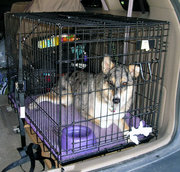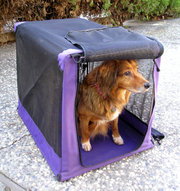 This Dog is relaxing in its familiar wire crate, which is strapped into a car
for safe traveling.
This Dog is relaxing in its familiar wire crate, which is strapped into a car
for safe traveling.
|
From Wikipedia the free encyclopedia, by MultiMedia |
Crate training is the process of teaching a Dog to go into its crate on command and to be comfortable there while enclosed. Dogs, like all canines, are den-dwelling animals by instinct and a crate becomes a den substitute, providing a familiar and safe haven for the Dog. A crate-trained Dog benefits the Dog and the Dog's owner in a number of ways.
 This Dog is relaxing in its familiar wire crate, which is strapped into a car
for safe traveling.
This Dog is relaxing in its familiar wire crate, which is strapped into a car
for safe traveling.
A crate can be used as an adjunct to housebreaking puppies. By instinct, most Dogs do not want to defecate or urinate in their den -- in this case, the crate.
The puppy is kept in the crate except during feeding time or during supervised play time. When the puppy comes out of the crate, he or she is taken to the "special area" and given encouragement to "go potty" or other predetermined voice command. When the puppy "goes potty" she or he is profusely praised. Until housebroken, the puppy is either in the crate or is closely supervised.
For maximum effectiveness, the crate must be just large enough for the puppy to be able to stand up, turn around, and lie down comfortably. If there is too much space, the puppy might use the unoccupied end as a bathroom. In addition, timing of the puppy's potty breaks are crucial. Even a confined puppy has a difficult time controlling its urination and defecation. Control gets better as the puppy gets older, but it is the owner's responsibility to ensure that the puppy has ample opportunities to eliminate outside the crate.
Toys and soft material for bedding in the crate make it more comforting for a Dog or puppy.
Even an adult Dog, when ill or affected by certain medications, can end up soiling the crate, making the Dog uncomfortable both physically and mentally, if the owner isn't vigilant and aware of the Dog's needs.
All veterinary clinics and hospitals keep Dogs in crates when the Dog must stay for observation or care. A Dog who understands the concept of a crate is much less likely to become stressed during medical care and is much easier for the staff to handle when putting him into the crate or removing him.
The same is true for kennels, where an owner might leave a Dog while out of town or during emergencies. In true emergencies, such as when an owner's home is destroyed or damaged by wildfires, floods, or earthquakes, a Dog who understands and is comfortable in a crate is much easier to manage while the owner is performing other tasks or while the Dog must be left in someone else's care in a situation that is also likely to be stressful to the Dog and make an unconfined Dog more likely to try to escape.
 A Dog who is familiar with crates so won't chew or dig at it can be placed in a
soft crate, which is easier to fold up and to carry than most wire crates.
Experienced crate-trained Dogs usually stay in the crate until verbally
released, even when the door is open.
A Dog who is familiar with crates so won't chew or dig at it can be placed in a
soft crate, which is easier to fold up and to carry than most wire crates.
Experienced crate-trained Dogs usually stay in the crate until verbally
released, even when the door is open.
A crate-trained Dog feels safe and comfortable in its familiar crate at home. When guests visit, when small children are present unattended, when construction occurs in the home, or in a myriad of other circumstances, it is convenient to be able to put the Dog into its crate, where it can relax and sleep, unattended, and the owner can also relax that the Dog will not be harmed, will not cause problems, and will not escape out an inadvertently open door. A crate with very see-through sides, such as a wire crate, can be made to feel more safe and enclosed by draping a towel or sheet over it.
When a Dog travels on an airline, he must be enclosed in a sturdy crate. Because travel is stressful for the Dog to begin with, as is separation from its owner, a Dog who is in a familiar and comfortable crate has a tremendous advantage over a Dog who must be forced into an unfamiliar crate along with all the other stresses of travel.
When a Dog travels by car, a loose Dog can create several hazards for itself or its human companions. For example:
For all the reasons that humans and children must be securely fastened in their seats, Dogs also should be. A crate that is securely strapped into the car provides an easy method to contain the Dog that still allows the Dog to move comfortably during travel.
Crate training usually involves rewarding the Dog for entering the crate and for remaining there, using the crate as part of a play session, feeding the Dog in the crate, allowing the Dog to explore and use the crate until it is no longer intimidating, and so on. This is only a summary of detailed techniques.
There are many types of crates, and variations within the types:
Dogs, made by MultiMedia | Free content and software
This guide is licensed under the GNU Free Documentation License. It uses material from the Wikipedia.